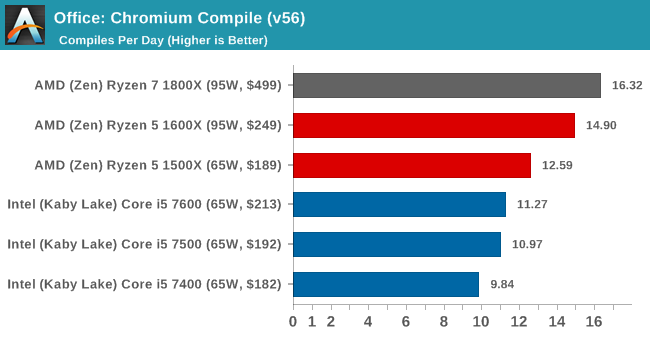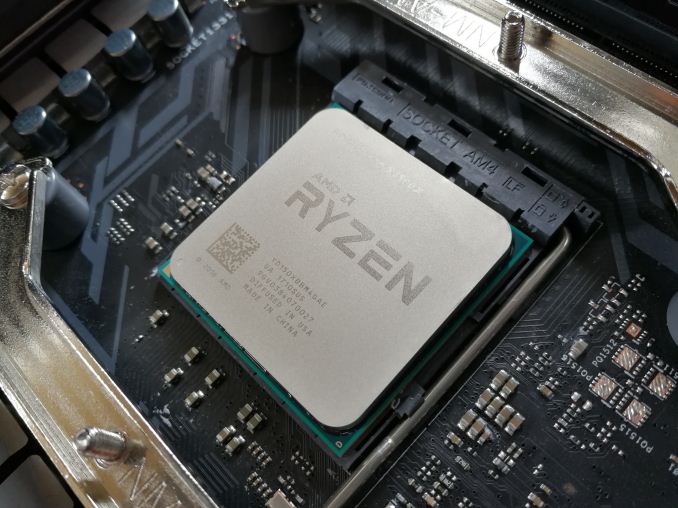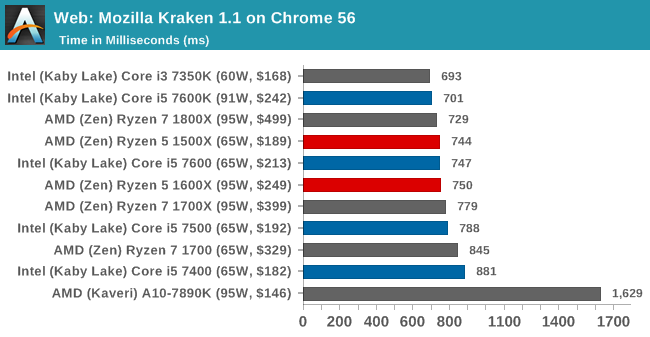The AMD Ryzen 5 1600X vs Core i5 Review: Twelve Threads vs Four at $250
by Ian Cutress on April 11, 2017 9:00 AM ESTAMD Ryzen 5
We mentioned at the top of the review that AMD’s Ryzen 7 launch last month benefited in a market where the competition was extremely expensive – being able to offer equivalent performance in most tasks and then undercut the competition by 50% is a difficult task, but the opening was always there due to a lack of competition in this space. When it comes to the mainstream market, the Ryzen 5 processors are actually competing on price with Intel’s processors directly, and thus has to offer something more to compete.
We have already shown in previous reviews that the Zen microarchitecture from AMD is around the equivalent of Intel’s Broadwell microarchitecture, but at this lower price point we have AMD’s Zen against Intel’s Kaby Lake, which is two generations newer than Broadwell and affords a comfortable IPC uplift over Broadwell. Given AMD’s monolithic design strategy of a single silicon die catering for most of their product line (well, all of it so far), the way AMD is tackling this is through more cores.
Before the debate about cores from AMD’s past rears its head (Vishera/Bulldozer designs in that case), given that AMD’s single thread performance is not too far behind, having a big set of cores as an alternative is something interesting for end-users, especially as more work flows and gaming titles rely on multithreading to scale. As a result, where Intel offer four cores and four threads, AMD is now offering six cores and twelve threads – a potential +200% uptick in the number of threads and +50% in cores, albeit at 10-15% lower instructions per clock.
(There’s also a side argument here about die sizes and wafer costs to each company to consider, but we will leave that for a different piece.)
For this review, based on time and available parts, we tested the Ryzen 5 1600X six-core processor against a set of Intel Core i5 parts that users might also be considering. We have some Ryzen 5 1500X quad-core numbers in here as well, and that might be spun out into a separate review at a later date. We also demonstrated our new 2017 CPU gaming tests, with four GPUs, six tests, two resolutions per test, and a couple of extra extreme resolution tests.
On The Benchmark Results
Looking at the results, it’s hard to notice the effect that 12 threads has on multithreaded CPU tests. The usual culprits show big wins for AMD here: 2D to 3D photo conversion, ray tracing, Blender, Cinebench, Encryption and video transcoding are all sizable wins. This is the sort of workload in which moving up to the Ryzen 7 CPUs, budget permitting, also do well on.
A new test in our suite for this review is a Compile Chromium test on Windows. As part of our testing suite, we have a fixed nightly download from mid-March and set this to compile, taking the final time and converting it into how many compiles per day. For around $250, Ryzen is the only way to go:

As you would expect, AMD still lags in IPC to Intel, so a 4.0 GHz AMD chip can somewhat compete in single threaded tests when the Intel CPU is around 3.5-3.6 GHz, and the single thread web tests/Cinebench results show that.
On The Gaming
Our gaming tests are a mix of Full-HD and 4K testing, some of which ends up being more CPU limited than we expected.
Civilization, at both 1080p and 4K Ultra settings, seem to scale quite happily with more cores on all GPUs, except the GTX 1060 at 4K. It’s worth noting situations such as the R9 Fury at 1080p Ultra only has 920ms under 60 FPS on the 1600X, compared to 6300 milliseconds on the Core i5-7600.
Shadow of Mordor leans towards the higher IPC of Intel, as the DX11 title cannot take advantage of the cores as much. Rise of the Tomb Raider’s benchmark is notorious for having each of its three seconds perform differently with respect to CPU scaling, with the Prophets scene being more CPU limited than the rest of the stage in the game.
Rocket League using an AMD CPU + AMD GPU actually provides more equal results with NVIDIA GPUs, however there's a performance drop using Ryzen + NVIDIA, which potentially correlates towards a driver bug but we're not 100% sure what is going on. Grand Theft Auto is a mixed bag, despite being a DX11 title – in some situations the Ryzen 5 is ahead of the Intel CPUs, or they all perform about the same, or the Intel CPUs pull ahead.
I have $250, What Should I Get – the Core i5 7600/7600K or the Ryzen 5 1600X?
Platform wise, the Intel side can offer more features on Z270 over AM4, however AMD would point to the lower platform cost of B350 that could be invested elsewhere in a system.
On performance, for anyone wanting to do intense CPU work, the Ryzen gets a nod here. Twelve threads are hard to miss at this price point. For more punchy work, you need a high frequency i5 to take advantage of the IPC differences that Intel has.
For gaming, our DX12 titles show a plus for AMD in any CPU limited scenario, such as Civilization or Rise of the Tomb Raider in certain scenes. For e-Sports, and most games based on DX9 or DX11, the Intel CPU is still a win here.












254 Comments
View All Comments
SkipPerk - Wednesday, May 3, 2017 - link
These are low-end CPU's. People use those for gaming and web-surfing. I have a proper Xeon machine at work like a normal person. Not to mention, you reference video software. What tiny percentage of computer users ever own or use video software? That is a tiny industry. It reminds me of the silly youtube reviews where the reviewer assumes everyone is editing videos, when less than one percent of us will ever do so.Most people buying non-Xeon CPU's really will be using basic software (MS Office, WinZip,...) or games. The only time I have used non-Xeon CPU's for work was when I had software that loved clock speed. Then I got a bunch of 6-core's and overclocked them (it was funny to watch the guys at Microcenter as I bought ten $1k CPUs and cheesy AIO water coolers). Otherwise one uses the right tool for the job.
AndrewJacksonZA - Tuesday, April 11, 2017 - link
On the last page, "On The Benchmark Results""Looking at the results, it’s hard to notice the effect that 12 threads has on multithreaded CPU tests."
Don't you mean that it's NOT hard to notice?
Drumsticks - Tuesday, April 11, 2017 - link
I didn't see the 7600k in gaming benchmarks, was that a mistake/not ready, or is it on purpose?Thanks for the review guys! This new benchmark suite looks phenomenal!
mmegibb - Tuesday, April 11, 2017 - link
I was disappointed not to see the i5-7600k in the gaming benchmarks. Perhaps it wouldn't be much different than the i5-7600, but I have sometimes seen a difference. For my next build, it's looking like it's between the 1600x and the 7600k.fanofanand - Tuesday, April 11, 2017 - link
"Platform wise, the Intel side can offer more features on Z270 over AM4"Aside from Optane support, what does Z270 offer that AM4 doesn't?
MajGenRelativity - Tuesday, April 11, 2017 - link
Z270 has more PCIe lanes off the chipset for controllers and such that AM4 does notfanofanand - Tuesday, April 11, 2017 - link
I won't disagree with that, but I'm not sure a few extra pci-e lanes is considered a feature. Features are typically something like M.2 support, built-in wifi, things like that. The extra pci-e lanes allows for MORE connected devices, but is a few extra pci-e lanes really considered a feature anymore? With Optane being worthless for 99.99999% of consumers, I'm just not seeing where Z270 gives more for the extra money.JasonMZW20 - Tuesday, April 11, 2017 - link
Let's do a rundown:Ryzen + X370
20 (3.0) + 8 (2.0)
Platform usable total: 28
Core i7 + Z270
16 + 14 (all 3.0)
Platform usable total: 30
Intel's Z270 spec sheet is a little disingenuous, as yes it does have a maximum of 24 lanes, but 10 are reserved for actual features like SATA and USB 2.0/3.x. 14 can be used by a consumer, giving you a total of 2 NVMe x4 + 1 NVMe x2 leaving x4 for other things like actual PCIe slots. That 3rd NVMe slot may share PCIe lanes with a PCIe add-in slot, if configured that way.
Ryzen PCIe config (20 lanes): 1x16, 2x8 for graphics and x4 NVMe (or x2 SATA when NVMe is not used)
Core i7 config (16 lanes): 1x16, 2x8, or 1x8+2x4 for graphics
They're actually pretty comparable.
mat9v - Tuesday, April 11, 2017 - link
No, not more PCIEx lines, those from chipset are virtual, they all go to CPU through DMI bus that is equivalent to (at best) 4 lines of PCIEx 3.0. All those chips (Intel and AMD) offer 16 lines from CPU for graphic card, but Zen also offers 4 lines for NVMe. Chipsets are connected by DMI (in Intel) and 4 lines of PCIEx 3.0 (in AMD), so that is equal, now Intel from those DMI lines offer virtual 24 lines of PCIEx 3.0 (a laugh and half) while AMD quite correctly offers 8 lines of PCIEx 2.0 (equivalent to 4 lines of PCIEx 3.0).psychobriggsy - Wednesday, April 12, 2017 - link
Indeed. If a user is going to need more than that, they're more likely going to be plumping for a HEDT system anyway. AMD's solution is coming in a bit, but that should be able to ramp up the IO significantly.